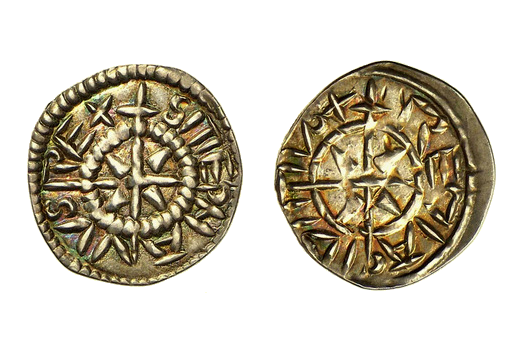
about ancient nomos
Ancient Nomos Art is a museum of galleries exhibiting ancient coins and ancient mint maps. The coin gallery displays the diverse art and history of hand-crafted ancient Greek, Roman, Byzantine, Persian and Medieval coinage. The ancient mints mapping gallery features Greek, Roman, Byzantine, Asia Minor and Medieval mint city regions and territories. Visitor's are welcome to explore, study and enjoy Ancient Nomos Art.

Medieval Hungary – 997 AD
St. Stephan I
From Ancient Galleries

Obverse: Central cross extending beyond a large inner beaded border, with four wedges in each quarter field.
Reverse: Central cross extending beyond a linear circle; with four outward pointing wedges in each quarter field.
LEGEND
Obv: + STEÞHANVS · REX ·, central cross extending beyond a large inner beaded border, with four wedges in each quarter field; all within pelleted border. Rev: + REΓIA CIΔITΔS (Γ retrograde; Δ upside down), central cross extending beyond a linear inner circle; with four outward pointing wedges in each quarter field; all within linear border.
This magnificent medieval Stephan I denar (some numismatists label the denomination an obol) was the first coin issued by the emergent Slav state of Hungary. These tiny silver denars are inscribed with Latin legends and symbolism designed after the static western Carolingian coinage, but are issued after earlier Bavarian coinage model types, circa 973 AD (P. Barford, The Early Slavs, 2001) Stephen I was likely born in 975 AD in the town of Esztergom and was given the Pagan name “Vajk” at birth. His father was the prominent ruling Magyar Prince Géza; his mother was Sarolt, the daughter of the prominent Transylvanian Gyulas. Vajk agreed at an early age to adopted the Christian religion and is thought to have been baptized at age 10 by Saint Adalbert of Prague. Some speculate that his baptism was his families precondition with the Church of Rome in anticipation of accepting a royal crown from the Pope. Vajk was given the Christian baptismal naming of Stephen (István), in honor of the original earlier Christian Saint Stephen. Between 995 AD and 997 AD, Stephen (still known as “Vajk”) was the lord of Nitra (a principality of Prince Géza). Shortly before his new lordship, Stephen married Giselle of Bavaria in 995 AD. Giselle was the daughter of Henry II “the Wrangler” Duke of Bavaria and mother Gisela of Burgundy, a prominent member of the Ottonian dynasty. After his marriage, Stephan I became the brother-in-law of the future Holy Roman Emperor Henry II, the last member of the Ottonian dynasty. Stephen and Giselle had at least three children in total including two sons, Imre (Emeric and future saint) and Ottó, with one daughter named Hedvig. In 997 AD, after the death of prince Géza a Hungarian succession struggle began between the major principalities. Stephen I had claimed the ancestral and divine right to rule the Magyars, while Stephen’s uncle Koppány, a prominent and strong pagan noble, claimed a regional and territorial right of sovereignty over Stephan. Eventually a regional battle ensued and Stephen I was able to claim victory, in large part due his alliance with medieval Germany and military assistance from the noble Poznan and Hunt families. Following this victory, Stephen became the Sovereign of the Magyars in Hungary (Transdanubia) in 997 AD. By 1006 AD he was able to unite the entire region of nearly all Magyar clans. His first Hungarian coinage likely began in 997 AD depicting an obverse Latin legend in his name, abbreviated as STEPHANVS REX. The reverse coin Latin legend states, CIVITAS REGIA, meaning the Kings Region or Kings Realm. According to Hungarian royal legends, after Stephan’s accession to the throne Pope Silvester II sent an exquisitely jeweled gold coronation crown and a sacred apostolic cross to this first Hungarian King, along with an important written letter from the Pope offering his blessing and recognition of Stephen I as first Christian King of Hungary. This legend of coronation is traditionally celebrated in Hungary and has been given the date of August 17, 1001 AD. Stephan I died on August 15, 1038 AD and was buried in the Basilica of Székesfehérvár, which was destroyed by fire in 1601 AD. Stephan had previously nominated his sister’s son, the Venetian Peter Orseolo (see Peter I denar), as his heir and second King of Hungary.
DOCUMENTATION
Value: Denier. Metal: AR Silver. Weight: 0.65 grams. Mint: Hungary. Date: Struck circa 997 – 1038 AD.
Attribution: L. Huszár. Münzcatalog Ungarn. Munich. 1979, coin 1; Réthy, coin 1; LHS 103, 2009, lot 46 (this coin); H.D. Rauch and Nudelman 2, 2005, lot 3 (this coin).
Legend, Documentation and Attribution
